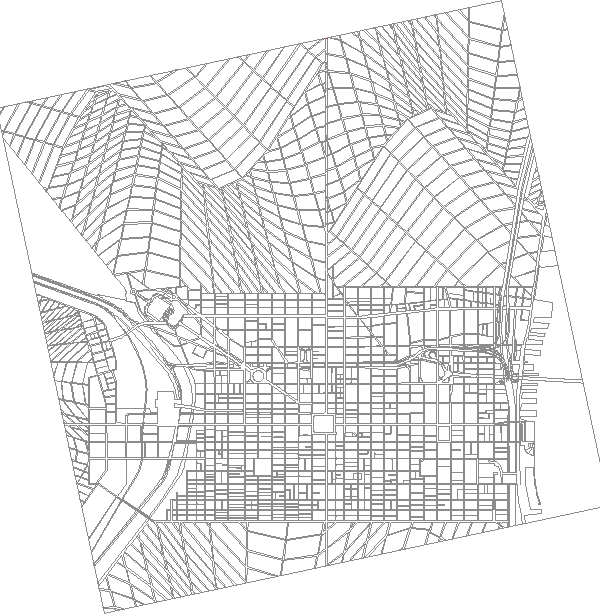2008.08.22 22:05
Peter's canon
Just did a side by side chronological overview of the work of Gehry and Eisenman, and in terms of architectonic, geometrical experimentation, Gehry manifests a greater and more mature repertoire.
Eisenman goes through a lot of intellectual and theoretical rigor to ultimately arrive at his geometry, but Gehry simply demonstrates that the intellectual and theoretical rigor isn't even necessary when it come to unprecedented architectonic geometries.
The only reason Eisenman's approach gets respect is because it fits well into 'higher' education. To have students pay large amounts of money to then learn that, "Hey, just look at Gehry, you can design pretty much anyway you want these days." just wouldn't go over well.
2008.08.23 21:06
Peter's canon
Personally, I like seeing all the study models of various projects by various architects. I like it because it clearly demonstrates just how pliant architectural designing can be. And I seriously consider the notion that it may well be Gehry that best introduced architectonic pliancy to the profession.
Is architectonic pliancy in somewhat sharp contrast to Eisenman's method? Up to a certain point (in time) I'd say yes. And when Eisenman's work started exhibiting some measure of pliancy, that's where I start to see Gehry's influence.
Have Gehry's designs of late become somewhat predictable and/or seemingly uninspired? Perhaps the pliability metaphor applies here too; perhaps the pliancy has been lost for being stretched too much and too far.
Another thing I like about all the study models is that so often almost any one of the models looks to be an exciting and/or interesting building. And often too it is within the collection of study models that one finds the riskier designs. "Getting it right" isn't the only operation going on. There's also a having-to-let-go of good designs.
2008.08.24 08:43
peter's canon
I am quite surprised by the many who have not recognized Gehry's influence. If anything, he joined and most clearly built a unity of modernist architecture as self referential practice of structure and the same as a flexible practice of hyper-noumena; that is to say a compound of the mineral tectonics of here-and-now and the sating buffet of architectonic plasma.
Modern architecture is fully present and wide awake, and all the quondam dreams and nightmares now manifest reality itself. Is not then a prescriptive therapeutic and/or pharmaceutical architecture surely to be marketed as well?
2008.08.26 16:50
"wildly influential" or really only virtually influential?
But is what Woods produces really anything more than an aesthetic?
| |
2008.08.26 20:17
"wildly influential" or really only virtually influential?
It's not a throwing out of the critical position, it's looking at the manifestations of the critical position and finding not much more than an aesthetic.
2008.08.29 08:04
Theory needed: contextualism/transparency
"Tafuri opposes the notion of operative criticism with that of historical criticism: in his view, criticism and history are identical--in other words, architectural criticism should always be historical criticism; what is more, there is a hiatus between architectural criticism on the one hand and architectural practice on the other. Architectural criticism (architectural criticism, that is) cannot be expected to offer any ready-made solutions for the problems that occur in the practice of the profession. All that history and criticism can do is clarify the context--in the broadest sense of the word--within which architectural production is carried out; they cannot provide any guidelines for its future development."
--the person who drove me back to my hotel after dinner at the Zenghelis/Gigantes residence.
Context used to be more real and is now more virtual.
Transparency used to be more virtual and is now more real.
I find that virtual criticism and virtual history are forward looking and trailblazing.
2008.08.29 16:16
Theory needed: contextualism/transparency
Keeping the criticism and the history in play keeps them virtual.
2008.08.29 16:29
Theory needed: contextualism/transparency
Also, Hejduk's oeuvre manifests an example of virtual criticism and virtual history.
2008.09:02 07:25
Theory needed: contextualism/transparency
Palais des Abuse Ridiculous
Cut & Paste Museum

ichnographia non-virtual non-context
3 black holes in the Michelin Misguide
atemporarily under deconstruction

virtue2vicegrip machine4living
you say: theory is only a textually generated infill (because the domineering cultures of this planet are text-based) in the gap between shelter and architecture.
I say: kaleidoscopic lacunae
| |
2008.09.03
ideas
1. working title: All Within Hadrian's Limits. A narrative non-fiction story of Piranesi's Ichnographia Campus Martius. The idea is to start writing with all the Hadrian related material: mother/son, Antoninus, Bustum, etc.
2. cut & paste museum: create a model of all the complete models; a "riff" off Gehry's so far unpublished (PMA) design.
3. create a Hejduk House 15 model using the pieces of Wall House 2.
2008.09.04 23:44
MVRDV masterplan in Tirana

design development like 8 years ago

"Hey, you're blocking my view!"
|